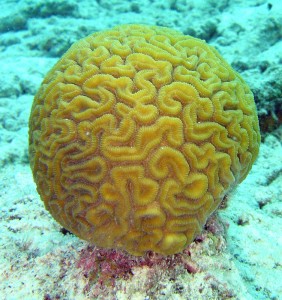- The pH scale is a measure of how acidic or basic a substance is. The scale ranges from 0-14.
- When something has a low pH (less than 7), it is acidic. The more hydrogen (H+) ions in a substance, the more acidic it is. When something has a high pH (greater than 7), it is basic. The fewer hydrogen (H+) ions in a substance, the more basic it is).
- pH is important because hydrogen ions, which are positively charged, alter the charge of the environment for nearby molecules. For example, proteins exposed to a very low pH may change their shape and cease to function.
- The ocean naturally has a pH level between 8.1 and 8.2.
- Marine organisms thrive this slightly basic environment and are very sensitive to even small changes in pH. The ocean is naturally buffered, meaning the pH is naturally controlled and held within the normal range. However, human activity can overwhelm this natural buffering system.
- When humans burn fossil fuels (fuels formed from decayed organisms preserved beneath the Earth’s surface over millions of years), we release carbon dioxide into the atmosphere. Some of this carbon dioxide stays in the atmosphere and traps heat, which causes global warming – an increase in global temperatures over time. The remaining carbon dioxide is used by plants or absorbed by the ocean.
- Carbon dioxide is released into the atmosphere naturally by many natural processes. The ocean can absorb and neutralize this naturally produced carbon dioxide without negative effects. However, anthropogenic (generated from human activity) sources release much higher carbon dioxide concentrations than natural sources. This excessive supply leads to “extra” carbon dioxide that the ocean cannot neutralize.
- Ocean acidification is the decrease in the pH of oceans water caused by the absorption of excess carbon dioxide from the atmosphere.
When carbon dioxide enters the ocean, it reacts with water in the following way:
CO2 + H2O –> H2CO3 –> H+ + HCO3- –> H+ + H+ + CO3(2-)
- Notice that when carbon dioxide (CO2) is combined with sea water (H2O), hydrogen ions (H+) are formed. Recall that the presence of hydrogen ions makes substances more acidic.
- During the Industrial Revolution (about 200 years ago), factories began pumping carbon dioxide into the atmosphere as a byproduct of manufacturing.
- Since then, ocean pH has decreased by 0.1 on the pH scale. Although this may seem like a small change, the pH scale is logarithmic. The 0.1 decrease represents a 30% increase in H+ ions over the past two centuries!
- Carbonate ions react with (H+), so when the ocean becomes more acidic, it causes the availability of carbonate ions to decrease.
- Calcifying organisms – marine organisms with skeletons made of calcium carbonate – are unable to survive and grow in the absence of carbonate ions.
- Creatures like plankton, sea urchins, corals, crustaceans, and mollusks are the first to be affected by ocean acidification.
- These small organisms form the base of the food chain. When their survival is diminished because of ocean acidification, larger predatory species are indirectly threatened.
- The ocean plays an important role in global temperature regulation. It acts as a “carbon storehouse”, absorbing and storing carbon dioxide from the atmosphere that would otherwise trap heat and further warm the planet.
- If we continue to release excessive quantities of carbon dioxide into the atmosphere, the ocean may reach its capacity as a carbon storehouse. It will no longer be able to absorb carbon dioxide from the atmosphere, and global warming will be accelerated.
Practice Good Stewardship
You can reduce the effects of ocean acidification by reducing your carbon footprint. Here are some easy things to try:
- As often as possible, bike or walk instead of driving.
- Turn out lights when you are not using them.
- Recycle. Recycling requires less energy than producing an entirely new product.
Review Questions
- What is anthropogenic carbon dioxide? Why does it have harmful effects on the ocean?
- What is ocean acidification and why does it occur?
- Why is ocean acidification dangerous for calcifying organisms?
Glossary
Anthropogenic: Caused by human activity.
Calcifying Organisms: Marine organisms with skeletons made of calcium carbonate.
Fossil Fuel: Fuel consisting of the remains of organisms preserved in rocks beneath the Earth’s surface over millions of years; includes petroleum, coal, and natural gas.
Global Warming: The increase in the average temperature of Earth’s air and oceans cause by excess carbon dioxide and other greenhouse gasses in the atmosphere.
Logarithmic: A scale that is based on the power to which each number must be raised in order to produce a given number.
Ocean Acidification: The ongoing decrease in the pH level of the world’s oceans.
pH Scale: A measure of the number of H+ ions in a solution.




